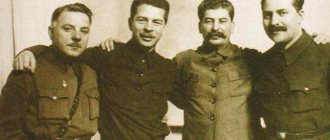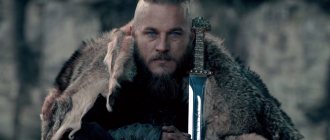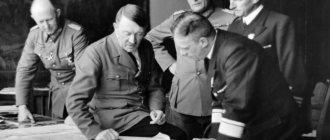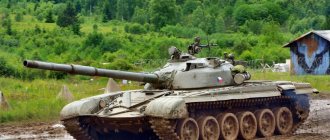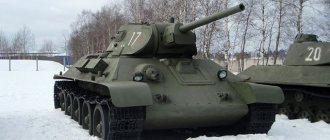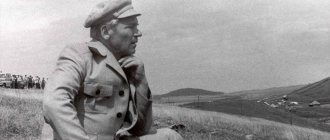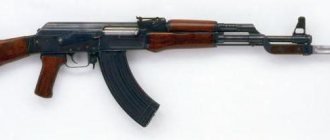The biography of Koshkin, the designer of the T-34 tank, is full of amazing stories, incredible accidents, amazing achievements and true heroism. This man was able to change the course of military history with his legendary invention. The T-34 tank is not just a combat vehicle that gave our army an advantage during the Second World War, it is a symbol that personifies faith in victory and the heroism of an entire people.
Biography
Mikhail Ilyich Koshkin was born in the Yaroslavl region, in a village called Brynchagi, on November 21, 1898. His family was very poor, his father worked hard in logging, when Mikhail turned 7, his father died - he overstrained himself and died. The widow was left with three small children in her arms. Mikhail and his brother helped their mother as best they could, tending pigs after school, but it was still not enough. Having graduated from only 3 classes of a parochial school, ten-year-old Mikhail, like another Mikhail - Lomonosov, goes on foot to Moscow in the hope of earning money for his family. He had relatives on his mother’s side in the capital, and he went to them. His mother provided him with a note with the address, but this important piece of paper was lost by Mikhail before he reached his destination. And this happened because on the way he came across a fight: several adult boys were beating one younger boy, the hero of our article could not pass by, he stood up for the weak. In the heat of the fight, the treasured note disappeared. And it is unknown how Mikhail’s future fate might have developed if not for a random passerby. He turned out to be a worker at a Moscow confectionery factory. He not only helped our hero, but also helped him get a job at the factory.
Working at the factory, young Mikhail established himself as a capable and conscientious worker. 8 years later he was already a workshop foreman, and he was not yet 19 years old.
At the beginning of the revolutionary year 1917, Mikhail was drafted into the army. He fought on the Western Front, was wounded and sent to a Moscow hospital, from where he was demobilized. But already in 1918 he returned to the army voluntarily, joining the ranks of the railway detachment of the Red Army. He took part in the hostilities near Tsaritsyn.
In 1919 he received a transfer to the Northern Front, where he fought in the battles for Arkhangelsk. On the way to Poland, Mikhail Ilyich fell ill with typhus. After recovery, he returns to the army, this time he fights on the Southern Front.
When the Civil War ended, he was sent to study at the Communist University. Y. V. Sverdlova. After graduating from university in 1924, he was sent to a confectionery factory in Vyatka. Here, as director, he proved himself to be a competent, sensitive and responsible leader.
Family
Mikhail Koshkin met his future wife while working in Vyatka. Vera Nikolaevna Kataeva was an employee of the Gubpotrebsoyuz. Here, in Vyatka, the eldest daughter Elizaveta is born. The family of Mikhail Koshkin lived on the territory of the Trifonov Monastery. Lisa will later tell many interesting details about this time. For example, how my father organized educational courses, where he studied and taught others. Or about how he gave salaries to his employees: on payday, Mikhail Ilyich invited the wives and children of his employees to his office, the children received sweets, and the wives were given a salary. This was done to ensure that workers did not have the opportunity to drink away the money the family needed.
In total, Mikhail Ilyich Koshkin had three children in his marriage: daughters Elizaveta, Tamara and Tatyana. The eldest became a geography teacher, Tamara chose the profession of geologist, and Tatyana taught at Kharkov University.
Design career
In 1929, at the personal request of Kirov, S. M. Mikhail Ilyich was sent to the Leningrad Polytechnic Institute, where he studied at the Department of Automobiles and Tractors. Having successfully graduated from the institution in 1934, Koshkin went to work at the tank design bureau of the Leningrad plant named after. S. M. Kirov. This is where the story of the legendary invention of the Soviet design engineer begins. At this plant, under the leadership of Koshkin, the T-29 and T-46-5 tanks were created.
Mikhail Ilyich Koshkin was sent to Kharkov in 1936, he took the position of head of the design bureau of plant No. 183. Our hero's first achievement was the modernization of the BT-7 tank, which consisted of installing the V-2 engine. This is how the world's first diesel tank appeared.
The first fully tracked tank was also developed by the design bureau, which was headed by Mikhail Ilyich Koshkin. Despite the skepticism of many authoritative colleagues, Koshkin was able to prove the superiority of caterpillar tracks over wheeled and mixed ones. The new tracked tank was called A-32. It showed excellent maneuverability in combat in rough terrain.
“We can’t tell you anything about Koshkin.” How the “grandfather” of the T-34 tank was shot and forgotten
On April 25, 1883, in the city of Berdyansk, Taurida province, a son, Afanasy, appeared in the family of a local merchant with many children, Osip Firsov (he had 14 children in total). The entrepreneur owned several stores and owned eight houses, so he could afford to give his children a decent education.
A day in history. March 4: 150 years ago, one of the fathers of Soviet tank power was born on the Cote d'Azur
©
RIA Novosti, Nikolay Kozlovsky / Go to photobank
Afanasy graduated from the railway school and then went to Mittweid (Germany), where he completed his secondary vocational education at a technical school. He received his higher education degree in Switzerland at the Polytechnic Institute of Zurich. The young Firsov gained his first work experience in the same country, engaged in the smelting of iron and steel, as well as the production of pumps and refrigeration equipment.
At that time, such education and work experience provided great respect in society and considerable wealth. Afanasy married his beloved Lyudmila Kharitonovna Litvinenko quite early. Already in 1905, the couple had their first child, Oleg, and three years later, their second son, Igor. The youngest daughter, Olga, was born in 1911.
In 1914, the First World War began.
The Firsovs decided not to sit out abroad when the Motherland was in danger, and went home, bypassing warring Europe, in a roundabout way through Arkhangelsk. Afanasy Osipovich got a job at a leading enterprise in the domestic mechanical engineering - Kolomna Plant, where he successfully worked on the creation of diesel propulsors for submarines.
In the spring of 1916, he switched to Nizhny Novgorod - minelayers were being built there. The Firsovs met the Revolution and Civil War in this city.
Afanasy Osipovich, from October 1917, during five tragic years for the country, headed the vocational education department in Nizhny. When the country began to switch to a peaceful path and the restoration of its industry began, the experience and knowledge of the honored engineer again became in demand.
Russia is the birthplace of elephants and tanks
©
Public domain
For the next five years - from 1922 to 1927 - he worked as the chief mechanic at Nizhny Novgorod, which produced fasteners and hardware, then in 1927 the Firsovs moved to Nikolaev, where the father of the family worked for three years at the Nikolaev Shipyard named after. Andre Marty.
By that time, the eldest son Oleg had grown up and received an education; following his father, he began to develop diesel engines (such specialists at that time were called “diesel engineers”). Then the family went to Leningrad, where the male part got a job at. The household of Afanasy Osipovich remained to live in this city, but not he himself - fate prepared the most difficult trials for him, thanks to which he entered the world history of tank building.
In the early 30s, the first wave of repressions among the military and intelligentsia swept across the USSR. One of its victims was Firsov - for participation in a “sabotage group” he was sentenced on June 23, 1930 to imprisonment in a forced labor camp (ITL) for a period of 5 years.
However, the country was experiencing a severe shortage of engineering personnel; sending such a person to Siberia to cut down forest was an unacceptable waste. Therefore, on September 18, 1931, the joint board of the OGPU revised his case No. 101032 and replaced the “camps” with work at the Kharkov Locomotive Plant. Comintern (KhPZ). It was this enterprise, together with the legendary Chelyabinsk Tankograd, that was destined to become the main manufacturer of Soviet tanks during the war years.
But in 1931 there was not even a hint of this. On the contrary, an unhealthy situation has developed at the plant, which requires a separate description.
“Kharkov has not changed its pace.” How the American giant of Stalinist industrialization was created
©
RIA Novosti, / Go to photobank
The future tank profile of the enterprise, which before the Revolution produced completely peaceful products, was determined by the “heating department” that emerged there in 1912, which two years later grew into a “heating department” - it developed and produced diesel engines so dear to Afanasy Osipovich’s heart.
In May 1923, the plant began work on converting the Ganomag WD-50 caterpillar tractor purchased in Germany under license to Soviet realities.
In April of the following year, this work was successfully completed, the resulting machine began to be called in the Soviet way - “Kommunar”. Its engine, instead of gasoline, which had huge problems in the young Soviet country, ran on kerosene. Increasing the size of the power plant required a complete redesign of the entire structure of the vehicle. For the same reason, all parts originally made of non-ferrous metals were replaced with cast iron. The frame was strengthened, since the Germans designed their tractor for operation in more gentle conditions (lighter soils and experienced tractor drivers) than those that existed in Soviet realities.
This is how Kharkov designers gained their first experience in designing tracked vehicles.
This success led to the plant receiving a government order in December 1927 for the development of the country's first medium tank of its own design, the T-12. At the same time, a specialized tank design group was formed at KhPZ, headed by Ivan Nikanorovich Aleksenko, a young and talented designer. However, developing a tank is much more difficult than developing a tractor.
Tests of the T-12 began only on April 2, 1930 and ended in complete failure - the tank covered only 2 km on the ground, its transmission broke, and the engine managed to run for 33 minutes.
Legs from Christie: how Kharkov became a tank forge
©
press service of the Popular Front party
The plant received from the customer clarifying parameters of the machine, which received a new index - T-24. During the July tests of 1930, just when Firsov was “resting” in the ITL, the tank’s engine caught fire, he was saved by the driver-mechanic Vladimirov, the only one who did not lose his head and put out the fire.
In August 1931, KhPZ received an order for the production of the first 300 armored vehicles, but their production was soon stopped (in total, the Kharkovites managed to make 25 T-24s), which led to a serious conflict.
In parallel with the development of tanks of their own design at Soviet enterprises, which proceeded very slowly and with great difficulties, the Soviet leadership considered the feasibility of launching licensed production of foreign models. It was assumed that it would be cheaper and faster to use Western design experience than to make mistakes by acquiring our own.
The Great Depression was raging in the capitalist countries, Western tank companies were experiencing enormous financial difficulties, and therefore licensed armored vehicles could be purchased even from such ardent opponents of the USSR as the USA and England.
In mid-1930, having outbid the Poles, the Soviet Union bought two tanks of his M1931 design and the rights to manufacture them from the American engineer-entrepreneur John Walter Christie. The machines arrived in the USSR in the spring of the following year, but without the towers and engineers needed to start production. As a result, the deal was not fully completed.
American “tractor” with Kharkov registration
©
the-legends.ru
In June 1931, KhPZ received a state order to develop its own vehicle based on the received tank chassis - work began on the creation of the BT tank (fast tank), which in February 1933 received the BT-2 index.
The work was difficult and creaking. For a long time, the tanks, having left the factory territory, stopped dead in their tracks before reaching the factory pigsty. This unfortunate pigsty became the subject of ridicule and cruel jokes; it was mentioned more than once at operational meetings with the plant director, in conversations with specialists, and even in the offices of the Main Armor Directorate of the People's Commissariat of Defense of the USSR. When the BT finally managed to safely pass the pigsty, it was perceived at all levels as a significant event.
The production program of 1931 turned out to be disrupted - by November 1, instead of six vehicles, only three were made, and then at the November parade, one of the tanks caught fire, and the other two were unable to reach the KhPZ from the center of Kharkov under their own power.
The head of the tank design bureau - T2K - designer Alekseenko, resigned in protest against the abandonment of the T-24. The head of work on the “American,” military engineer 2nd rank Nikolai Mikhailovich Toskin, was recalled to Moscow for disrupting the work. The director of the plant, Ivan Petrovich Bondarenko, although he continued to work, turned to Moscow with an official protest.
It was in these difficult conditions that Afanasy Osipovich arrived in Kharkov. On December 6, 1931, he headed the tank design bureau... and the work began.
In 1932, KhPZ produced 396, and in 1933, another 224 BT-2. In 1932, based on the old model, designers created a new, more advanced tank - the BT-5. In 1935, the BT-7 appeared. These vehicles, which could move both on tracks (max. speed 50 km/h) and on wheels (70 km/h), were called jumping tanks. Having accelerated and jumped from a cliff or a special springboard, the tank could fly 20-30 meters through the air. The absolute record is 42 meters.
Designer Morozov: the man whose tanks are fighting in Donbass
©
btvtinfo.blogspot.com
In fact, with the arrival of Firsov at KhPZ, work began on various units and design solutions, many of which were later organically included in the design of the T-34. The main one was the V-2 tank diesel engine, which in a modernized form is still installed on the most modern Russian T-72 and T-90 vehicles of the latest modifications.
It all started in October 1932, when KhPZ received an order for the production of a 12-cylinder diesel engine BD-2 (“high-speed diesel engine”) with a capacity of 400 hp. With. at 1700 rpm with specific fuel consumption of 180-190 g/l. With. per hour in tank and aviation versions. Kharkov residents showed the first BD-2 to the country's leadership at the end of 1934, for which the plant was awarded the Order of Lenin on March 27, 1935.
The chief designer of the KhPZ diesel engine, Konstantin Fedorovich Chelpan, argued that it was Firsov who made a significant contribution to its development.
In his manuscript “Memories of Tank Builders and Diesel Builders,” Vasily Nikitich Vasiliev, who was at the origins of the creation of the T-34 tank engine, recalled:
“Official Soviet historiography connects the creation of the famous T-34 tank exclusively with the name of chief designer Mikhail Koshkin, who replaced the repressed Afanasy Firsov in December 1936. But the foundations for the creation of the T-34, its primary technical appearance, and main combat characteristics were laid back under Firsov.
Already at the end of 1935, well-developed sketches of a fundamentally new tank lay on the chief designer’s desk: anti-ballistic armor with large angles of inclination, a long-barreled 76.2 mm gun, a V-2 diesel engine, a weight of up to 30 tons...
Firsov's closest assistants in these developments were Alexander Morozov and Mikhail Tarshinov. The same conflict occurred during the creation of the famous V-2 diesel engine, which is still used on modern tanks. The pioneer is Konstantin Chelpan, his successor is Ivan Trashutin.”
Tank Marathon by Mikhail Koshkin
©
Public domain
In 1935, the large Kyiv maneuvers were carried out, which revealed a large number of shortcomings in the BT tanks. By the summer of 1936, the troops received 687 new BT-7 tanks, which suffered massive gearbox failures. The representative of the military acceptance department of the Red Army Armored Directorate at plant No. 183 (as KhPZ had become known by that time) stopped accepting finished vehicles and in his report called the BT-7 (which later showed itself to be excellent in Spain) a “wrecker tank.”
Well, who could harm the Soviet government in the first place? Of course, the merchant's son and former conscript Firsov - in the summer of 1936 he was removed from the leadership of the design bureau.
Nevertheless, Afanasy Osipovich continued to fight for the tank, which in fact, in his conditions, turned into a fight for life. In a short time, a much more reliable new gearbox was developed and went into production.
Under the leadership of Firsov, it was designed by Alexander Alexandrovich Morozov - the future chief designer of plant No. 183 during the most difficult and decisive war years for the country, the creator of the T-34-85, T-44, T-54, T-64 and others - the absolute world record holder for the production of tanks of his design. All his life Morozov considered Firsov his teacher.
Firsov designs the installation of a flamethrower and smoke devices on the BT-7, personally meets and brings up to date the new head of the tank design bureau, Mikhail Ilyich Koshkin, the officially recognized creator of the T-34 tank...
A day in history. December 19: T-34 - the birth of a legend
©
Public domain
Nothing helped. On March 14, 1937, Afanasy Osipovich was arrested as a member of a sabotage organization and by the military collegium of the Supreme Court of the USSR on December 10 of the same year he was sentenced to capital punishment with confiscation of property. The honored designer was shot on the same day. The place of his burial is unknown.
20 years later, on July 12, 1957, Afanasy Osipovich was rehabilitated for lack of evidence of a crime. Until the end of the 1980s, the name of Afanasy Osipovich was not mentioned in the press or research works. The situation has changed since the 00s, when the personality of the outstanding engineer and his contribution to domestic tank building became widely known.
But that was later, and in the late 30s, after Firsov’s arrest, a wave of repression began at the plant, caused by the fact that the development of new machines was slow, and the existing ones were breaking down. Nobody wanted to take into account the fact that the workers still had low production discipline, and the tanks were such complex products that it was almost impossible to create them quickly and without problems.
The creator of the V-2 diesel engine, K. F. Chelpan, was shot. Along with him, the NKVD also arrested ordinary diesel designers: Chelpan’s deputy I. Ya. Trashutin (who managed to avoid death - he was released in February 1939), G. I. Aptekman, M. B. Levitan, Z. B. Gurtovoy (these specialists were shot), chief engineer of the KhPZ F.I. Lyashch, chief metallurgist A.M. Metantsev and many others.
On May 25, 1938, I.P. Bondarenko, director of the KhPZ, found himself on a bunk and was soon shot. The first developer of the T-34 prototype, 3rd rank military engineer A. Ya. Dik, “sat down” on his bunk for 10 years.
The authorities announced the official creator of the T-34 tank I. I. Koshkin. Firsov’s students had their own opinion about the contribution of various Kharkov engineers to the creation of the T-34 tank. Designer Leonid Nikolaevich Kartsev, who replaced A. A. Morozov in 1953 as general designer of plant No. 183 in Nizhny Tagil, recalled:
A day in history. January 23: 75 years ago the most famous Soviet tank was put into service
©
RIA Novosti, Nikolay Maksimov / Go to photobank
“After... a letter [with Kartsev’s request to perpetuate the memory of Koshkin - Approx. author] a Komsomolskaya Pravda correspondent came to Nizhny Tagil... and interviewed all former Kharkov residents... After Nizhny Tagil, the correspondent went to Kharkov. When he came to Morozov, he told him: “Neither I nor any of my employees can tell anything about Koshkin.”
But Kharkov residents also continued to remain silent about Firsov.
His son Oleg followed in the footsteps of Afanasy Osipovich. He became the chief designer of the Leningrad Shipyard, and in the 60s he received the USSR State Prize. The youngest son, Igor, volunteered for the front in the first days of the war and died. Daughter Olga forever inscribed her surname and her father’s surname, which she did not give up after his arrest and did not change after his marriage, in the history of Leningrad. She personally and a team of climbers under her leadership camouflaged the Admiralty spire during enemy raids. Half of the climbers died.
Thus, the creative spirit of Afanasy Osipovich was passed on to both his students and children, who made a huge contribution to the development of the country, which continues to serve it and protect it from external enemies to this day/
Birth of a legend
The use of a diesel engine, as well as a five-wheel caterpillar track, opened up new opportunities for improving tanks. To prove this, at the end of 1939 - beginning of 1940, Koshkin built two prototypes of the tank, which were assigned the index A-34. Compared to previous models, this tank had several serious advantages, including a significant increase in combat weight (by 10 tons) and a doubling of the armor thickness. The A-34 became the prototype for the T-34.
While working on the drawings of the "thirty-four", Mikhail Ilyich devoted himself entirely to this process, practically living at the plant. In relation to his work, he was always very demanding of himself and those around him, assertive, purposeful and principled. It was this ability to work until complete self-forgetfulness that made him a specialist of the highest class.
Mikhail Koshkin created the first prototypes of the T-34 tank in the spring of 1940. By March, two copies had been produced. Despite the fact that the tanks were already on the move, their total mileage did not yet allow them to proceed to public testing. According to the standards, the speedometer of each tank had to show indicators of over 2000 km. Meanwhile, on March 17, a show of new equipment was supposed to take place in the Kremlin.
The entire biography of the designer of the T-34 tank Koshkin indicates that this man was not afraid to make difficult decisions and never ran away from responsibility. The current acute situation with a public demonstration for the highest echelons of power was no exception. Mikhail Ilyich found the only possible, but extremely risky, solution - he decides to drive the tanks to Moscow under his own power. This simultaneously made it possible to conduct field tests and gain the required mileage.
The situation was further complicated by the fact that at that time the T-34 was a classified product, it was impossible to openly demonstrate it, which means the route was built to bypass roads and populated areas in order to prevent the disclosure of state secrets. Besides, there was still snow. And Stalin was waiting in Moscow at the appointed hour. The conditions are truly extreme.
Now it is probably difficult to imagine what a monstrous responsibility lay on Koshkin, not only as a designer, but also as a person who decided to make the run. Without exaggeration, he risked not only his freedom, but possibly his life. If something went wrong, he would have to answer to Stalin.
On the night of March 6, a column with two camouflaged tanks set off. Mikhail Koshkin often sat behind the levers of T-34 tanks on the road. All design flaws, which manifested themselves in multiple minor breakdowns, were eliminated in the field.
Almost a week later, on March 12, the tanks were in Moscow, and on the 17th a triumphal demonstration took place in the Kremlin. Joseph Vissarionovich was pleased.
Creation of the A-20 and A-32 tank
The task for the development of a new tank BT-20, which eventually received the index A-20, was issued in October 1937. Within a few months, the Koshkin Design Bureau was able to develop a sketch of the new vehicle, as well as test the B-2 diesel engine on the BT-7. In this context, the idea arose to convert the new tank completely to caterpillar tracks.
In April 1938, Koshkin sought permission to develop a tracked version of the A-32 in parallel with the A-20. Approval was expressed by I.V. Stalin, who proposed not to limit the initiative of the design bureau and the plant. By the end of that year, three prototypes had been developed - one A-20 and two A-32.
Tests of both models were carried out in the first half of 1939. The wheeled-tracked A-20 showed good speed and maneuverability. The A-32 had better maneuverability and armor, while there was a resource for further strengthening it. The commission was unable to decide on preferences; further work was carried out on two models at once.
By the end of the year, Koshkin presented the updated A-32 with a 76.2 mm cannon. The tank received the index T-32 and was positioned as a medium tank with ease of manufacture and good opportunities for further modernization. However, officials continued to hesitate.
Death
Unfortunately, the nightmare conditions of transporting tanks from Kharkov to the capital did not pass without a trace for Mikhail Ilyich. Koshkin caught a bad cold. The situation worsened during the return journey, when one of the tanks fell into the water and he participated in the recovery of the vehicle. The disease worsened, turning into pneumonia, which became the cause of the death of Mikhail Koshkin.
He did not stop working, despite the acute course of the disease and hospitalization. Soon it was necessary to remove the lung, which had ceased to function, but this could no longer save Mikhail Ilyich’s life.
Koshkin died on September 26, 1940 in a sanatorium near Kharkov. He was buried at the Kharkov First City Cemetery.
Memory
In Kharkov in 1985, a monument to Mikhail Koshkin was erected. Also one of the city streets bears his name.
There is a monument to the designer in the Yaroslavl region, in the center of the village of Brynchagi, where he was born.
In Kirov (formerly Vyatka) on house No. 31 on Spasskaya Street there is a memorial plaque. Mikhail Ilyich lived and worked in this house. There is also a memorial plaque installed on the building of St. Petersburg State Polytechnic University, since he studied here. And another memorial plaque is located in Kharkov, it is installed on the house where the designer lived with his family, at the address: Pushkinskaya Street, 54/2.
There is also a monument to the legendary T-34 tank, it is located on the federal highway M-8, not far from the turn sign to the village of Brynchagi.
In addition to architectural structures, the achievements of the design engineer M.I. Koshkin are captured on the pages of books - this is “The Creation of Armor” by Ya.L. Reznik, the brochure “Mikhail Koshkin: unique documents, photographs, facts, memories”, published for the 110th anniversary of our hero, “ A tank that was ahead of time" and "Constructors" by V. A. Vishnyakov.
Also in 1998, a postage stamp was issued with the image of Koshkin himself and his main invention.
From caramel to tanks
Studying the young years of Mikhail Koshkin, the question arises: how did a person so far from mechanical engineering later become a famous tank designer?
Domestic tank building before 1929 was a pitiful sight. Its own production lagged behind world developments by ten years; the army had at its disposal a small number of captured vehicles. Providing troops with modern armored vehicles was a key point in maintaining the country's defense capability.
Due to the lack of a sufficient number of qualified personnel, it was decided to send many political workers for retraining. Among them was Mikhail Koshkin, who had to sit at the desk of the Leningrad Polytechnic Institute at the age of 30. As a student at the Faculty of Mechanical Engineering, he completed an internship at the design bureau at the Leningrad Experimental Mechanical Engineering Plant No. 185. The topic of his thesis was the gearbox of a medium tank, which was soon installed on the experimental T-29.
After graduating from the institute, Mikhail Koshkin worked in Leningrad for 2.5 years, rising from an ordinary design engineer to deputy head of a design bureau. At the end of 1936, he was appointed head of the tank design bureau at Kharkov plant No. 183. It is within its walls that the legendary “thirty-four” will be designed.
War and tanks
M.I. Koshkin died nine months before the start of the war; he never had the opportunity to witness the triumph of his most advanced development.
By the time the war began, the Soviet Union had 1225 T-34 units. Although the tank was in the middle class, it was equipped with excellent armor and a powerful weapon, which allowed it to engage in confrontation with heavy class vehicles, such as the German Tigers and Panthers. The latter were many times longer-range, but could not penetrate the armor of the “thirty-four”, and he, in turn, although from a shorter distance, confidently hit enemy equipment. At that time, the Germans did not have a tank in their arsenal that could withstand a direct hit from the T-34.
And this was not his only advantage. Unprecedented maneuverability made it possible to fight in any, even the most difficult, conditions. The T-34 passed where, according to the enemy, it was simply impossible to pass.
Our vehicle was not only superior to German tanks, it was the best in the world. Even after capturing the T-34 model that survived the battle, the Germans were unable to create a copy of it, although many ideas were adopted in further developments. We can say that the German “Panthers” and “Tigers” were created precisely as a response to the Russian T-34.
This tank on the battlefield caused horror among enemy tankers and delight among their designers. Müller-Hillebrandt, a German major general, even spoke about the development of “tank fear” in the ranks of the German troops.
Some design elements remained a sealed secret for them, for example, a special method of hardening steel for the manufacture of tanks - submerged arc welding, developed by the Soviet academician E. O. Paton.
Until the end of the war, the T-34 did not give up its leadership position in the global tank building market. Technological features and mass production capabilities led to the fact that it went down in history as the most popular tank of the Great Patriotic War.
Kharkov period
From left to right - BT-7M, A-20, T-34 (1940) and T-34 (1941)
At the end of December 1936, on the initiative of Ordzhonikidze, Koshkin was transferred to the Kharkov plant. The transfer was due to the difficult situation in the tank department and the difficulties of working on the BT-7 light tank. The desire of the designer himself to create a fast medium tank for mass production was also taken into account.
The direction to Kharkov appoints M. Koshkin as the head of the tank KB-190. The situation with the BT-7 was complicated by the arrival of several hundred tanks with a defective gearbox into the army. The situation was complicated by overworked personnel; the tank department was simultaneously working on fourteen projects.
Along with this workload, a general crisis in the tank-building industry emerged. The Spanish Civil War showed the inability of light Soviet tanks to conduct effective combat operations. There were no vehicles with reinforced armor in production, and they could not strengthen the existing BT-7 due to the reached weight limits and load on the transmission part.
Military officials continue to burden the plant with new requirements and tasks. The development of projects is complicated by personnel changes. Under these conditions, Koshkin forms his own KB-24, into which he himself selects people on a voluntary basis. He appoints A. A. Morozov as his deputy.
"Chief Designer"
The biography of the designer of the T-34 tank M. I. Koshkin was the basis for the book “The Creation of Armor” by Ya. Reznik. The film “Chief Designer” was based on this work.
The plot is based on the real story of the transfer of the first prototypes of the T-34 from Kharkov to Moscow for demonstration in the Kremlin and back to the plant in Kharkov.
The role of Koshkin in the film was played by Boris Nevzorov. The film was released in October 1980.
"Tanks" and "T-34"
There are a lot of stories about the legendary Soviet car that went through the entire war. They were preserved in archives and memories, and were embodied in literature and cinema.
In April 2022, the film “Tanks” was released. It was directed by Kim Druzhizhin. The role of Koshkin was played by Andrey Merzlikin. The film offers the viewer an alternative story in the adventure genre, far from real historical facts, about how Mikhail Koshkin made a secret forced march to Moscow on prototypes of the T-34. The biography of the designer of the T-34 tank M. I. Koshkin is interpreted very freely in this work of cinematic art. According to the plot of the film, its goal is to obtain permission for the mass production of a new type of tank. Those same “thirty-fours” that helped win the Great Patriotic War.
The film was received rather coolly by Russian critics. There are conflicting reviews among viewers, but most of those who speak out agree that this is an entertaining movie.
In December 2022, we will see the premiere of another Russian film about a tank. It is called, like the combat vehicle itself, “T-34”. The plot is based on the story of cadet Ivushkin, who is captured by the Germans. The hero plans to escape using a T-34 tank captured by the Nazis. He manages to assemble the crew of the car among other prisoners of war. He challenges German ace tankers, including Jager himself. The main male role in the film is played by Alexander Petrov.
You can have different attitudes towards the films about the “victory tank” released on wide screens, but their undoubted advantage is that every viewer after watching will know that the chief designer of the victorious T-34 tank was Mikhail Ilyich Koshkin. A man who always smiled, never raised his voice, was as unpretentious in everyday life as he was demanding in work. A man who laid down his life to give his homeland the T-34, the importance of which for the Soviet army cannot be overestimated.
When World War II ended, W. Churchill called the Soviet “miracle tank” T-34 one of the three decisive weapons of the ended war.
Best Award
Of course, the T-34 continued to improve. So in 1944, the T-34-85 modification appeared in service with the Red Army. The new tank received an 85 mm cannon, was superior to its predecessor in terms of armor protection, and as a result, was better able to withstand the German Tigers and Panthers.
T-34-85 tanks of the 6th Soviet Guards Tank Army on the coast of Liaodong Gulf
But Mikhail Koshkin did not see the triumph of his brainchild. After that famous run, upon arrival in Kharkov, he ended up in the hospital. Doctors diagnosed him with a serious form of pneumonia. On September 26, 1940, Mikhail Ilyich Koshkin passed away. He was only 41 years old.
Posthumously, in 1942, he was awarded the Stalin Prize. Half a century later, in 1990, he became a Hero of Socialist Labor. But, perhaps, the real reward for Koshkin was the role that the T-34 played in the Great Patriotic War. Who knows what the fate of our country would have been like if exactly 90 years ago, the head of the confectionery factory, Mikhail Koshkin, had not decided to choose a completely different path in life.
At the upcoming celebration of the 75th anniversary of Victory in the Great Patriotic War, the legendary “thirty-four” will proudly lead the parade columns. Uralvagonzavod enterprises have already completed work on restoring and preparing 13 historical tanks for the parade.

